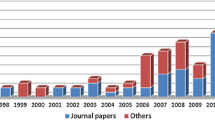Abstract
According to the randomness of the vessel’s arrival time and handling time, the establishment of a randomly-oriented environment container berths—crane allocation model, the optimizing goal is to minimize the average ship-waiting time. Taking into account the complexity of the model solution, this paper offers the design of an improved genetic algorithm to reduce the searching space, and according to the characteristics of the optimal solution. With testing example to verify that the model can simulate decision-making environment of berths—crane allocation problem and reflect the decision-maker’s attitude toward risks and preferences. The algorithm can gain a stable and satisfactory solution within the operating time.
Access this chapter
Tax calculation will be finalised at checkout
Purchases are for personal use only
Similar content being viewed by others
References
Lai KK, Shhi K (1992) A study of container berth allocation. J Adv Transp 26(l):45–60
Imai A, Nagaiwa K, Tat CW (1997) Efficient planning of berth allocation for container terminals in Asia. J Adv Transp 31(1):75–94
Imai A, Nishimura E, Papadimitriou S (2001) The dynamic berth allocation problem for a container port. Transp Res Part B 35:401–417
Lim A (1998) The berth scheduling problem. Oper Res Lett 22:105–110
Kim KH, Moon KC (2003) Berth scheduling by simulated annealing. Transp Res Part B 37:541–560
Li CL, Cai X, Lee CY (1998) Scheduling with multiple-job-on-one-processor pattern. IIE Trans 30:433–445
Guan YP, Xiao WQ, Cheung RK et al (2002) A multiprocessor task scheduling model for berth allocation: heuristic and worst case analysis. Oper Res Lett 30:343–350
Acknowledgments
This work was supported in part by the National Natural Science Foundation of China under Grants 61170078 and 60773034; the National Basic Research Program of China (973 Program) under Grant 2010CB328101; and the Scientific and Technological Developing Program of Shandong Province of China under grant 2011GGX10114.
Author information
Authors and Affiliations
Corresponding author
Editor information
Editors and Affiliations
Rights and permissions
Copyright information
© 2013 Springer-Verlag Berlin Heidelberg
About this paper
Cite this paper
Liu, Jx., Du, Yy., Hong, Yf., Sun, Ll. (2013). Berth-Crane Allocation Model and Algorithm of Container Berths in the Uncertain Environment. In: Yin, Z., Pan, L., Fang, X. (eds) Proceedings of The Eighth International Conference on Bio-Inspired Computing: Theories and Applications (BIC-TA), 2013. Advances in Intelligent Systems and Computing, vol 212. Springer, Berlin, Heidelberg. https://doi.org/10.1007/978-3-642-37502-6_93
Download citation
DOI: https://doi.org/10.1007/978-3-642-37502-6_93
Published:
Publisher Name: Springer, Berlin, Heidelberg
Print ISBN: 978-3-642-37501-9
Online ISBN: 978-3-642-37502-6
eBook Packages: EngineeringEngineering (R0)




